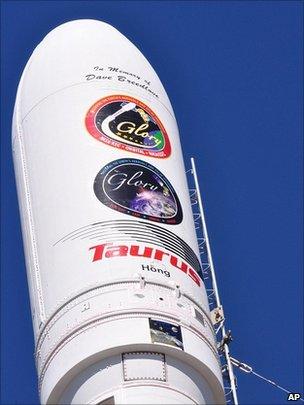Nasa Glory mission ends in failure
- Published
Nasa Earth observation satellite launch fails
The US space agency's (Nasa) attempt to launch its latest Earth observation mission has ended in failure.
The Glory satellite, external lifted off from California on a quest to gather new data on factors that influence the climate.
But about three minutes into the flight, telemetry indicated a problem.
It appears the fairing - the part of the rocket which covers the satellite on top of the launcher - did not separate properly.
This would have made the rocket too heavy and therefore too slow to achieve its intended 700km orbit.
"All indications are that the satellite and the rocket are in the Southern Pacific Ocean somewhere," said launch director Omar Baez.
The loss of the $464m (£260m) Glory mission is a huge blow to the Orbital Sciences Corporation (OSC) as well as Nasa. The company makes the rocket and assembled the Glory satellite for the space agency.
Climate change
Exactly the same problem befell Nasa's Orbiting Carbon Observatory (OCO) in 2009. It too launched on a Taurus XL rocket from the Vandenberg Air Force Base, and again the fairing failed to separate properly.
On that occasion a "Mishap Investigation Board" was established to determine the root cause of the nose cone's failure and to make recommendations to remedy the malfunction. Following the board's findings, OSC took the separation initiation system used on another of its rockets, the Minotaur 4, and installed it on the XL. Friday's launch was the XL's return to flight after the OCO loss.

A system that had performed well on another rocket was installed on the Taurus XL
"There's a great deal of emotional investment on the part of all the players on any spaceflight but that's doubly so on a return to flight," said Ron Grabe, the general manager of OSC's launch services group. "I think it's not an understatement to say that tonight we're all pretty devastated."
Glory was carrying two instruments. One of its instruments would have measured the total energy coming from the Sun; the other would have looked at particles in the atmosphere that can trap that energy or scatter it back out into space.
Understanding both is vital to our ability to forecast future climate change.
The Taurus XL is the smallest ground-launched rocket currently in use by the US space agency.
Since its debut in 1994, this type of rocket has flown nine times, with six successes and three failures including this launch. This was the second time Nasa had tried to launch a satellite on the XL.
The OCO mission which failed in 2009 is being rebuilt and is due to be launched on another Taurus XL rocket in 2013.
"OCO-2 is in development and a couple of years away from launch yet," explained Mike Luther, a senior official from Nasa headquarters in Washington DC. "We'll have to evaluate the outcome of this investigation and we'll adjust our plans accordingly."

How Glory might have looked in orbit. Its failure puts at risk a 33-year, continuous record of total solar irradiance monitoring that stretches back to Nasa's Nimbus-7 spacecraft
The British OCO scientist, Dr Paul Palmer from Edinburgh University, commented: "This is another big blow for the Nasa Earth science programme, particularly because the reason for the failure appears to be the same as that which affected the OCO launch.
"It's also sad news for the climate community - Glory promised to provide important information we desperately need for better understanding Earth's radiative balance," he told BBC News.
"Sometimes we forget, because we rely on satellites every day, that launching instruments into an Earth orbit is still a risky business and that we should expect a few failures."
Of particular concern will be the failure to get Glory's Total Irradiance Monitor (TIM) into space. The TIM would have extended a continuous data record of the solar energy striking the top of Earth's atmosphere that goes back to the late 1970s and the Nimbus-7 satellite.
How much energy is put into the Earth's climate system is a key parameter for understanding how it works, and spotting real trends is made easier if the data-sets are long and unbroken.
- Published18 February 2011
- Published13 April 2014
- Published24 August 2010
- Published23 September 2010